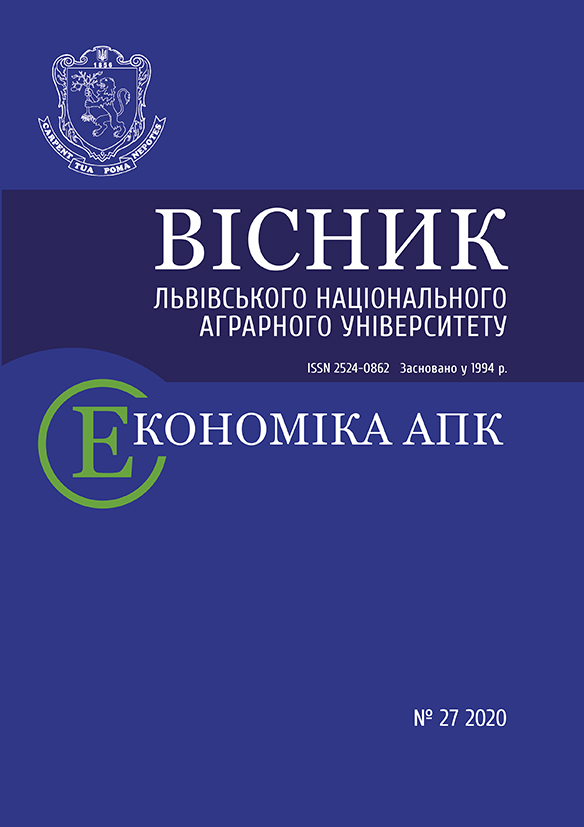Visnyk LNAU: Agronomy 2020 №24: 181-186
Innovative models of soil fertility elements management
R. Truskavetskiy, Doctor of Agricultural Sciences
ORCID ID: 0000-0002-2542-8527
V. Zubkovskaya, Candidate of Agricultural Sciences
ORCID ID: 0000-0002-8124-8635
I. Khyzhniak, junior research scientist
ORCID ID: 0000-0003-4950-3752
National Scientific Center «Institute for Soil Science and Agrochemistry Research named after O. N. Sokolovsky»
https://doi.org/10.31734/agronomy2020.01.181
Annotation
The article is devoted to the theoretical principles of system management of soil regimes, solving problems of accurate diagnostics and balanced optimization of soil fertility elements. The main attention is focused on the problem of diagnostics and optimization of fertility elements, the solution of which is carried out on the theoretical basis of indicators of buffer properties of soils – evaluation criteria of self-regulation of their regimes (fertility factors). The buffering capacity of the soil relative to nutrients should be interpreted as the ability of the soil to resist changes in the concentrations of these elements in the soil solution (intensity factor – FI) under the influence of increasing doses and, conversely, when removing them from the soil solution. First of all, are to be diagnosed, the main factors and elements of fertility – the parameters of their pool, dynamism, processes of mobilization and immobilization under different load conditions. Graphical optimization models are created on the basis of initial data with the obligatory parametric display of the limits and intervals of the optimal, preferably also acceptable and unsatisfactory agroecological state of the fertility element. The optimal parameters, which are an integral part of the management model, for each individual biogenic element are determined experimentally for different buffer properties of soils and in relation to a particular culture or group of physiologically close crops. Methods of optimal management of the main functions of soils involve the selection and search for the most effective options for agro-technological operations. To do this, use, first of all, the reaction of plants to changes in the state of fertility elements in the soil environment. Optimization involves the use of a set of measures aimed at the transfer and constant maintenance of each element of fertility in the optimal parameters for plants in both spatial and temporal dimensions.
Innovative models of management of soil fertility elements, that are built on factors of their intensity, parameters of agroecological condition and indicators of buffer properties allow to calculate doses, to make an effective choice of methods of application and to determine the duration of the aftereffect of fertilizers, ameliorants and other agro-technological operations, to neutralize the negative effects on the functioning of soil systems.
Key words
fertility elements, diagnostics, optimization, intensity factor, potassium buffering, phosphate buffering
Link
- Aslyng H. C. The lime and phosphate potentials of soils; the solubility and availability of phosphates. Royal. Vet. Agr. Coll. Copenhagen: Jearb, 1954. Vol. 1. P. 1–50. https://doi.org/10.1097/00010694-195407000-00015
- Balyuk S. A., Truskavetskyi R. S. Models of system management of soil fertility potential (on the example of Kharkiv and Volyn regions) / ed. by S. A. Balyuk and R. S. Truskavetskyi. Kyiv-Kharkiv, 2018. 116 p.
- Beckett P. H. T., White R. E. Studies of the phosphate potentials of soils. Part III: The pool of labile inorganic phosphate. Plant and Soil. 1964. Vol. 21. № 2–3. P. 253–282. https://doi.org/10.1007/BF01377744
- Fundamentals of soil fertility management / R. S. Truskavetskyi, Yu. L. Tsapko; ed. by R. S. Truskavetskyi. Kharkiv: FOP Brovin O. V, 2016. 388 p.
- Gnativ P. S., Snitinskyi V. V., Nechay O. S., Zinyuk O. D., Pasichnyk T. V., Zelisko O. V. Ecosystems and systems analysis: a scientific monograph / ed. by P. S. Hnativ and V. V. Snitinskyi. Lviv: PRO Color, 2017. 416 p.
- Shoba S.A. Horizons of soil science: results and prospects. Soil science. 2009. №5. P. 515–520. https://doi.org/10.1134/S1064229309050019
- Snitynskyi V., Hnativ P., Zinyuk O., Korinets Yu., Datsko T. System approach in agroecology: research and educational aspects. Bulletin of LNAU: agronomy. 2019. №23. P. 34–40. https://doi.org/10.31734/agronomy2019.01.034
- Sokolov M. S., Dorodnykh Yu. L., Marchenko A. I. Healthy soil as a necessary condition of human life. Soil science. 2010. № 7. P. 858–866. https://doi.org/10.1134/S1064229310070112
- Sokolovskyi A. N. Agricultural soil science. Moscow, 1956. 332 p.
- Strategy of balanced use, reproduction and management of soil resources of Ukraine / ed. by S. A. Balyuk and V.V. Medvedev. Kyiv: Agrarian Science, 2012. 239 p.
- Truskavetskyi R. S. Buffer capacity of soils and their main functions. Kharkiv, 2003. 225 p.



